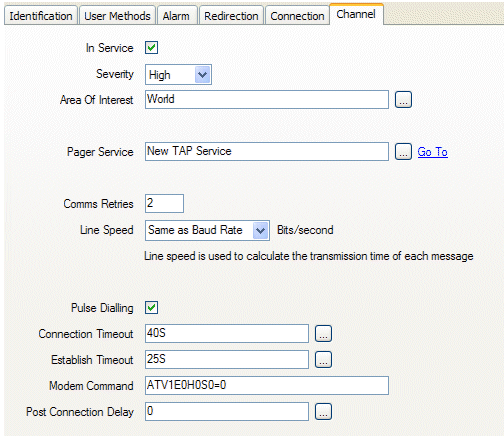To configure a PSTN Pager Channel:
- Display the Pager Channel Form. If the Pager Channel you want to configure does not already exist in the database, you will need to Create a Pager Channel Database Item, then display its Form.
- Configure the Identification, User Methods, Alarm, and Redirection properties as required. These properties are common to many types of database item (see Tabs on Configuration Forms).
- Configure the properties on the Connection tab (see Configure a Channel’s Connection Properties in the ClearSCADA Guide to Drivers). The properties vary according to the Connection Type you select (see Configure a Channel’s Connection Type in the ClearSCADA Guide to Drivers).
- Display the Channel tab.

- Configure those properties on the tab that are common to many Pager Channels (see Configure the Common Channel Properties for a Pager Channel).
- Configure the properties that are specific to PSTN Pager Channels:
- Pulse Dialing—Use the Pulse Dialing check box to define whether the PSTN exchange (to which the modem represented by the Pager Channel is connected) uses Pulse Dialing or Tone dialing (Dual Tone Multi-Frequency). Select the check box if Pulse Dialing is used, or clear the check box if Dual Tone Multi-Frequency is used.
For more information, see Define whether a PSTN Pager Channel uses Pulse Dialing or Tone Dialing.
- Connection Timeout—Define the amount of time the Pager Driver will wait for the local modem to connect to the remote modem (see Define the Connection Timeout for a PSTN Pager Channel).
- Establish Timeout—Define the amount of time the Pager Driver will wait for the remote modem to respond to an 'establish' message that has been sent by the Pager Driver. The time you enter has to be in the OPC Time Format.
The default time of 25 seconds is usually applicable, but you may need to change the setting if messages fail consistently.
For more information, see Define the Establish Connection Timeout for a PSTN Pager Channel.
- Modem Command—Enter the Modem Command that is required to initialize your modem. The default entry provides the minimum command required to allow ClearSCADA to initialize the modem. Depending on the type of modem being used, you may need to apply additional commands. For more information, see Define the Modem Command for a Pager Channel.
- Post Connection Delay—Define the amount of time the Pager Driver waits between detecting the modems have connected and transmitting the first message. Normally, you only need to change this setting from 0 if you are using GSM modems, as these are known to experience lag for a short time after the connection is established.
If you are using GSM modems, we recommend that you set the Post Connection Delay to 2S (2 seconds). You need to use the OPC Time Format.
For more information, see Define the Post Connection Delay for a PSTN Pager Channel.
- Save the configuration (see Saving Configuration Changes in the ClearSCADA Guide to Core Configuration).